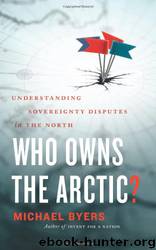Who Owns the Arctic? Understanding Sovereignty Disputes in the North by Michael Byers

Author:Michael Byers [Byers, Michael]
Language: eng
Format: epub
Tags: General, History, Political Science, Law, Nature, Environmental Conservation & Protection, World, book, government, ebook, Canada, Ecosystems & Habitats, Federal, Canadian, Polar Regions
ISBN: 9781926706962
Publisher: Douglas & McIntyre
Published: 2009-02-15T07:14:18+00:00
Chapter Six
Who Owns the Seabed?
“THE ARCTIC IS RUSSIAN.” With four simple words, Artur Chilingarov, who led the expedition that planted a titanium Russian flag on the ocean floor at the North Pole, commanded global media attention in August 2007.
Observers of Russian politics took the assertion with a large grain of salt. They knew that Chilingarov was a member of the Russian Duma, in the midst of an election campaign. As Russian Foreign Minister Sergei Lavrov later explained, the flag plant was just a publicity stunt and had not been approved by the Kremlin. Lavrov compared the flag plant to the 1969 U.S. moon landing, and he was right to do so. Descending 4,000 metres below the thick, shifting ice of the Arctic Ocean is a technological feat that, at the moment, no other country could match. And like the U.S. astronauts who planted a flag on the moon, the Russian scientists were not, in fact, claiming sovereign territory.
But Canadian Foreign Minister Peter MacKay had already taken the bait. “Look, this isn’t the fifteenth century,” he exclaimed. “You can’t go around the world and just plant flags and say, ‘We’re claiming this territory.’ Our claims over our Arctic are very well established.” MacKay’s statement obscured the fact that Canada has never claimed the North Pole and that just two years earlier Canadian soldiers had flown to Hans Island to plant a Canadian flag.
Like their Russian and Danish counterparts, generations of Canadian politicians have learned that Arctic sovereignty is good election fodder. But Arctic sovereignty is never just a domestic issue; it also involves relations with other, often much more powerful countries. Playing the sovereignty card badly can have a negative impact on seemingly unrelated global matters that are sensitive and vitally important— such as nuclear disarmament talks between Russia and the United States. The negative impact can be magnified since journalists tend to pay more attention to confrontation than to cooperation. Chilingarov’s and MacKay’s comments led to a rush of excited reporting about an upcoming conflict over Arctic resources. Some headlines portrayed a North that was teetering on the brink of war.
In a deliberate response to all the misreporting, the Danish government invited the foreign ministers of the other four Arctic Ocean countries to Ilulissat, Greenland, in May 2008. The summit culminated in the Ilulissat Declaration, in which all five states reaffirmed their commitment to working together within an existing framework of international law. “We have politically committed ourselves to resolve all differences through negotiations,” explained Danish Foreign Minister Per Stig Møller. “And thus we have hopefully, once and for all, killed all the myths of a ‘race to the North Pole.’ The rules are in place. And the five states have now declared that they will abide by them.”
CANADA–S MOON MISSION: THE EXTENDED CONTINENTAL SHELF
Considerable excitement has been generated by U.S. Geological Survey reports that the Arctic might contain as much as 83 billion barrels of oil and 44 trillion cubic metres of natural gas. However, as noted in Chapter
Download
This site does not store any files on its server. We only index and link to content provided by other sites. Please contact the content providers to delete copyright contents if any and email us, we'll remove relevant links or contents immediately.
The Pirates of Somalia by Jay Bahadur(1544)
Political Theology by Carl Schmitt(1504)
The Holocaust: A New History by Laurence Rees(1447)
The Social Animal by David Brooks(1361)
A Practical Guide to International Arbitration in London by Hilary Heilbron(1347)
Restitution by Restitution(1331)
Pirates of Somalia by Jay Bahadur(1305)
Coercing Virtue by Robert H. Bork(1267)
The Nuremberg Interviews by Leon Goldensohn(1209)
Basic International Corporate Taxation by Sebastiano Garufi(1127)
A History Of Thailand by Baker Chris(1099)
The Global Commons by Susan J. Buck(1065)
Asian Waters by Humphrey Hawksley(1060)
International Trade and Business: Law, Policy and Ethics by Gabriël Moens & Peter Gillies(1058)
Blood Profits by Vanessa Neumann(1047)
Spring Fever: The Illusion of Islamic Democracy by McCarthy Andrew C(1043)
The Sovereignty of Human Rights by Macklem Patrick(1007)
The Nuremberg Trials: The Nazis and their Crimes Against Humanity by Roland Paul(986)
Crimes Against Humanity: Historical Evolution and Contemporary Application by M. Cherif Bassiouni(964)
